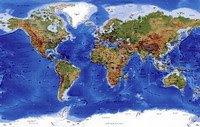 The FATS family has many members, such as saturated fats, polyunsaturated fats, and monounsaturated fats. Some of them are good, while others are bad; Some are natural fats, while others are simply artificial or man made. Trans Fats, or Trans-Fatty Acids, are largely artificial fats (a small amount of trans fats occur naturally in meat and dairy products) , and they are real bad fats! Trans fats are made by a chemical process called partial hydrogenation, where hydrogen atoms are added to liquid vegetable oil (an otherwise healthy monounsaturated fat) and converted into a solid fat. In short, it transforms liquid fats to become solid fats at room temperature. This makes what seemed an ideal fat for the food industry to work with because of its high melting point, its creamy, smooth texture and its reusability in deep-fat frying.
The FATS family has many members, such as saturated fats, polyunsaturated fats, and monounsaturated fats. Some of them are good, while others are bad; Some are natural fats, while others are simply artificial or man made. Trans Fats, or Trans-Fatty Acids, are largely artificial fats (a small amount of trans fats occur naturally in meat and dairy products) , and they are real bad fats! Trans fats are made by a chemical process called partial hydrogenation, where hydrogen atoms are added to liquid vegetable oil (an otherwise healthy monounsaturated fat) and converted into a solid fat. In short, it transforms liquid fats to become solid fats at room temperature. This makes what seemed an ideal fat for the food industry to work with because of its high melting point, its creamy, smooth texture and its reusability in deep-fat frying.Because of its altered and enhanced properties, trans fats extend shelf life of food. They also add a certain pleasing mouth-feel to all manner of processed foods. Think of buttery crackers and popcorn, crispy french fries, crunchy potato chips, creamy frosting and melt-in-your-mouth pies, cakes and pastries. All these foods owe those qualities to trans fats.
Hydrogenated fats were initially seen as a healthier alternative to saturated fats: using margarine was deemed better for us than using butter, yet numerous studies now conclude that trans fats are actually worse. True, saturated fats raise total and bad (LDL) cholesterol levels. Trans fats do the same, but they also strip levels of good (HDL) cholesterol, the kind that helps unclog arteries. Trans fats also increase triglyceride levels in the blood, adding to our risk of cardiovascular disease. Basically, the more solid the fat at room temperature, the more it clogs our arteries.
Continue to Part 2...
(Words Count: Approximately 293)








